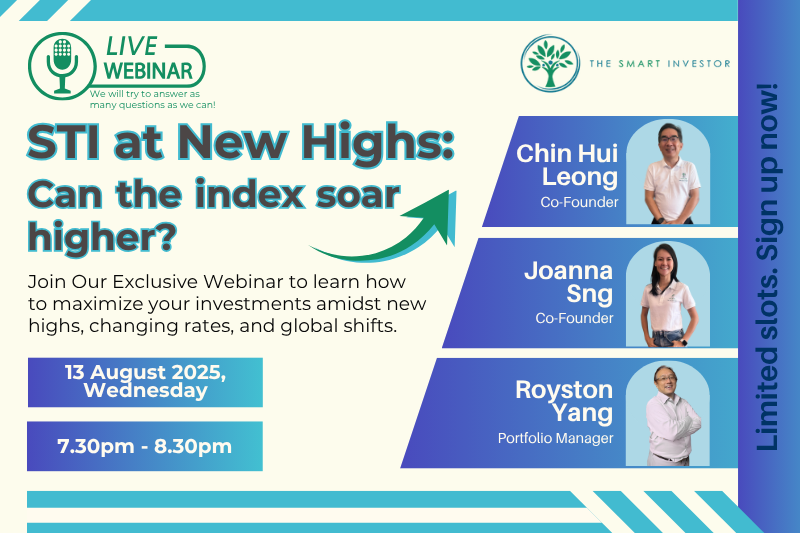Singapore’s Straits Times Index (SGX: ^STI), or STI, has enjoyed a streak of strong performance.
2024 saw the bellwether blue-chip index chalk up a 23.5% total return, beating many regional indices and registering its best performance in a decade.
2025 saw yet another milestone for the STI as it broke past the 4,000 level, hitting an intra-day high of 4,005.18 on28 March.
With this psychological barrier broken, can the index power on to greater heights? What can investors expect?
A cautious business environment
It’s worth noting that the STI’s rise above 4,000 could not be sustained, and it ended the day at 3,972.43, down 0.2%.
Singapore Exchange’s (SGX: S68), or SGX, market strategist Geoff Howie remarked that the index’s rise coincided with the release of Singapore’s 2024 gross domestic product of 4.4%, implying a positive business outlook.
However, as we step into 2025, investors have turned cautious because of President Trump’s tariff tirade.
The imposition of various tariffs by the US threatens to reignite inflation and raise costs for a wide swath of businesses.
Retaliatory tariffs announced by different nations could extend the trade war and consumers will end up bearing the brunt of this bruising campaign.
Hence, many businesses are adopting a wait-and-see attitude for now before committing to capital expenditure or spending plans.
Banks are leading the charge?
With the three big banks taking up a nearly 54% weight within the STI, it’s natural to assume that they have been responsible for the index’s charge.
DBS Group (SGX: D05), Singapore’s largest bank, put up a stellar 2024 performance with its share price leaping 43.9%.
Not to be outdone, OCBC Ltd (SGX: O39) and United Overseas Bank Ltd (SGX: U11), or UOB, also chalked up 2024 gains of 28.4% and 27.7%, respectively.
During the most recent earnings season in February 2025, DBS reported a sparkling set of earnings with its 2024 net profit rising 11% year on year to S$11.4 billion.
Similarly, both OCBC and UOB also saw their 2024 profits hit new records.
OCBC’s net profit jumped 8% year on year to S$7.6 billion and UOB saw its net profit last year climb 6% year on year to S$6 billion.
You may be surprised, though, that the three banks have only logged single-digit share price increases year-to-date.
DBS led the pack with a 5.7% gain (as of 31 March) while OCBC and UOB chalked up gains of 4% and 4.2%, respectively.
In an environment with cautious business sentiment, these lenders could see loan growth slowing.
Meanwhile, the US Federal Reserve could also go ahead with its planned rate cuts for 2025, reducing interest rates further.
Should rates fall, the banks’ net interest margins and net interest income will be negatively impacted.
Standout performers
Despite the lacklustre share price performance of the banks, several other blue-chip companies picked up the slack.
Singapore Technologies Engineering (SGX: S63), or STE, became the STI’s star performer this year with a 46% year-to-date gain.
The engineering firm released a commendable set of earnings with net profit climbing nearly 20% year on year to S$702.3 million.
Its order book also hit multi-year highs at S$28.5 billion as of 31 December 2024 after snagging S$12.6 billion of new contracts last year.
STE also released its Investor Day 2025 slides as it gears up for further growth in profits and dividends in the years ahead.
Sembcorp Industries (SGX: U96) also saw a near-15% year-to-date rise in share price as the utility group more than doubled its final dividend to S$0.17 from S$0.08.
And let’s not forget Singapore’s largest telco Singtel (SGX: Z74).
The group saw its share price rise 11% year-to-date as investors cheered its capital recycling plans and the declaration of a value realisation dividend.
Should these companies continue to post higher profits and dividends, their share prices could continue to climb, with the STI moving correspondingly higher.
Get Smart: Be selective
Rather than fixate on the index itself, investors should be selective about which companies they include in their portfolios.
Remember that the STI is also a barometer of sentiment that provides a window into the emotional tone of the market.
Ultimately, the index will be driven by higher earnings from its underlying companies such as the banks, Singtel, STE, and others.
There could be sharp fluctuations in the months ahead as investors hold back because of macroeconomic worries.
But if earnings and dividends continue to climb, the STI should eventually stay above the 4,000 mark convincingly.
We’ve discovered 5 SGX stocks that not only offer better returns than fixed deposits but also have the potential to beat inflation. Plus, these stocks provide capital growth and can significantly compound your wealth in the long term. If you’re looking to make your money work harder for you, download our FREE report for details on these five stocks.
Follow us on Facebook and Telegram for the latest investing news and analyses!
Disclosure: Royston Yang owns shares of DBS Group and the Singapore Exchange.






